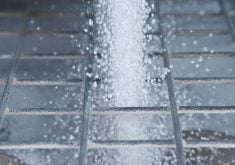The affect of tile drainage depends on the nature of the cropland and how it is connected to nearby rivers and streams. If tile drains a low spot where water used to remain in the field, it could increase the amount of nutrients leaving the cropland.
On the other hand, the soil filters out nutrients in the water as it moves through the soil matrix.
Mitchell Timmerman, Manitoba Agriculture agri-ecosytems specialist, said the Manitoba Livestock Manure Management Initiative is seeking a more comprehensive answer to the question. It recruited two groups, University of Manitoba scientists and experts with Stantec engineering, to review the scientific literature on tile and nutrient loss. They are expected to submit their reports later this spring.
In Ontario, tile drainage is not a hot discussion topic at rural coffee shops. Few farmers there feel the need to talk about it because most realize it’s worth the investment.
“We don’t have any trouble convincing landowners in this area to tile drain. That is not an extension question…. You don’t have to sell tile drainage in Ontario,” said Kevin McKague, water quality engineer with the Ontario Ministry of Agriculture.

Research carried out in the late 1970s and early 1980s showed that tile drainage, which is perforated pipe buried under cropland, improved Ontario corn and soybean yields by 20 to 40 percent, McKague said.
Those numbers explain why 45 percent of the province’s cropland has tile drainage.
In southwestern Ontario, it approaches 85 percent.
Ontario producers are tile believers but the story is much different in Manitoba. Potato producers spend $700 to $1,000 per acre to install drainage under their land, yet many growers remain skeptical.

The price tag is substantial, but producers need to think about tile as a long-term investment in water management, said Hans Kandel, extension agronomist with North Dakota State University.
Read Also

House ag committee to undertake several studies
The House of Commons standing agriculture committee has set its agenda for the coming months. Members began the fall sitting with a two-hour update on international trade
Farmers in his state, particularly the eastern half of North Dakota, are installing tile on thousands of acres every year. Much like Ontario, the skeptics have become the minority.
“We are losing yields to excess moisture and that is fairly well documented,” Kandel said from his office in Fargo. “There are very few farmers who put in tile… and will tell you ‘man, it was a dumb decision.’ ”
North Dakota research suggests tile improves yields by 10 percent, on average, but the larger benefit is likely yield stability. Tile drainage will protect crop yields when a 100 mm rain falls over the weekend in June or early July.
“It’s not the total amount (of annual rain) but the amount that comes in one shot,” Kandel said.
“If we can help to alleviate the stresses on the plant… that will help build in a buffer in the system…. Is tile a tool to mitigate uncertainty? In my mind it is.”
Estimates suggest about half of the potato acres in Manitoba operate with tile drainage. Assuming another 5,000 to 25,000 acres have tile, Manitoba may have 40,000 to 60,000 acres with tile drainage.
The province has about 11.6 million acres of cropland, so 0.3 to 0.5 percent may have tile.
What if Manitoba farmers increased that percentage to 25 percent? Would it have a considerable impact on crop yields, farm profitability and Manitoba’s economy for decades to come?
Data from the Manitoba Agricultural Services Corp. (MASC), the provincial crop insurer, shows excess moisture represented 54 percent of all crop losses between 2005 and 2014. Drought or heat was 24 percent. During that decade, the excessive moisture claims were highest in:
- 2005: $295.2 million
- 2010: $210.6 million
- 2011: $326.9 million
- 2014: $200 million
- Total: $1.032 billion
Of those years, overland flooding was most severe in 2011, when 3.5 million acres of cropland went unseeded or was drowned out.
In total, from 2005 to 2014 there were about 10.7 million acres of unseeded and drowned out claims.
Since Manitoba has about 11.6 million acres of cropland, that is almost the equivalent of losing an entire year of production between 2005 and 2014.
From 2010 to 2014, according to Statistics Canada, Manitoba farm cash receipts for crops averaged about $3 billion per year.
However, the economic impact is larger than $3 billion because farmers buy things like seed, fertilizer, tractors, and pay for agronomic services when they grow a crop.
There are also indirect benefits to the economy, as input suppliers, grain marketers, elevators, grain processors and machinery dealers may expand or hire more people when crop production increases.
A 2014 report on the economic impact of agriculture in Lethbridge County determined that farmers in the region received $175 million for their crops in 2011.
Serecon Services, an Edmonton firm that authored the report, used multipliers to estimate the economic impact of the crop receipts.
Serecon said the $175 million in cash receipts boosted the economy in Lethbridge County by $371 million.
Using that study as a template:
- $3 billion in crop cash receipts represents an economic impact of $6.36 billion in Manitoba.
- The crop insurance loss for excess moisture from 2005-14 was more than a billion, so losing 10.7 million acres of crop production cost Manitoba’s economy about $7.36 billion over the decade.
The causes of flooding were significantly different in 2011 and 2014. In 2014, a late June rainfall dumped 125 to 175 millimetres of precipitation in a couple of days, swamping crops across southwestern Manitoba and southeastern Saskatchewan.
In 2011, soils were inundated with water going into the winter and hundreds of farmers never got a chance to seed because fields never dried up.
Looking back at the four wet years:
- In 2005, 1.4 million acres were too wet to seed and 900,000 acres of planted crop were drowned out.
- In 2010, 635,000 acres were left unseeded and one million acres of crops were drowned out.
- In 2011, 2.9 million acres went unseeded and 500,000 acres of crops were drowned out.
- In 2014, 988,000 acres were unseeded acres 600,000 acres of crops were drowned out.
One of the benefits of tile drainage is that soils drain throughout autumn until freeze-up, reducing soil moisture levels going into the winter, said Avery Simundsson, a project leader with the technology research agency PAMI in Portage la Prairie.
So tile drainage would have mitigated the amount of ponding during spring seeding, but it’s unlikely that tile would have saved all the flooded fields in years like 2011 and 2014.
For the sake of an estimate, it’s possible that tile could have saved 50 to 80 percent of the 10.7 million acres written off because of excess moisture.
Given that range:
- If 100 percent of the affected acres had tile drainage, it would have provided $3.68 billion to $5.9 billion in economic benefits. Assuming an economic loss of $7.3 billion.
- If 25 percent of affected acres had tile, the economic benefits would have been $920 million to $1.47 billion.
Of course, on-farm decisions are based on the costs and benefits to the operation, not what it means to the overall economy.
Farmer experience and research data from North Dakota has convinced Kandel that tile is worth the up-front cost.
“I know the tile is going to be there for 60 to 70 years. Based on all our models, I am 98 percent sure it’s going to repay (the investment)…. Some (farmers) they repaid (the investment) in a few years. Some say they repaid the cost of the tile in 10 years.”

Carl Classen, who farms near Elm Creek, Man., installed tile drainage to improve the productivity of his existing acreage.
“It doesn’t make sense to buy extra land if that land also has problems,” said Classen. “I’m going to keep on going (more tiling). I think it works really well.”
Kandel said tiling also makes sense in the drier parts of North Dakota, including the prairie pothole region.
With rolling land it’s rarely necessary to tile an entire section, but the underground pipe could salvage low-lying pockets within a field.
“It’s not a blanket treatment, it’s a targeted treatment… (for) certain areas that are troublesome,” Kandel said.
Tile drainage, as its name suggests, removes water from the land. But when Kandel talks about tile he likes to use the phrase water management.
Tile can be installed with control boxes, which can be used to manipulate the flow out of the tile lines. Therefore, producers can use the control boxes to influence the water table during the growing season.
“There are various ways that farmers are starting to think… about water as a (managed) resource… . To set the water table with a control box… at a level that matches the crop stage.”
Classen and others are experimenting with tile that drains into an on-farm retention pond. The water can be stored and potentially used to sub-irrigate a field, through the tile, during dry periods.
Kandel made a point of saying that wetlands should not be drained with tile and many fields don’t need underground pipe. Nonetheless, millions of acres in the Northern Plains might benefit from tile.
“If there is a need to tile, why not?”


















